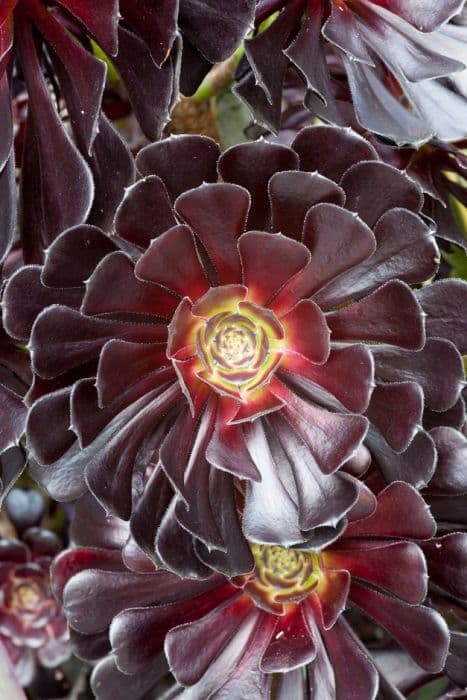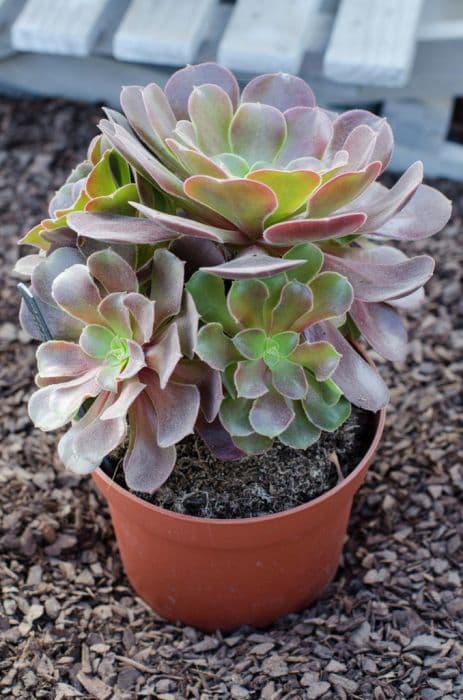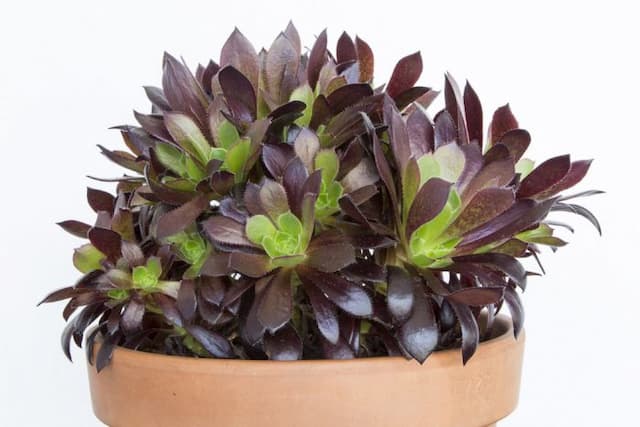Hen and Chicks Sempervivum 'Kramer's Spinrad'

ABOUT
Sempervivum 'Kramer's Spinrad', commonly known as hens and chicks, is a captivating succulent that displays a symmetrical rosette pattern. Each rosette is an intricate cluster of tightly packed, fleshy leaves. These leaves are typically pointed at the tips and may have a plush, velvety texture. The coloration of 'Kramer's Spinrad' is particularly striking, with leaves often boasting a blend of deep greens that can have reddish-purple undertones that become more pronounced under stress, such as cooler temperatures or drought. Most striking during the growing season, this variety of hens and chicks can develop a dynamic color transition that adds to its ornamental appeal. The leaves might also display a subtle transition of colors from the center of the rosette to its outer leaves, further adding dimension to the plant's appearance. Additionally, the edges of the leaves may show a hint of a different hue, almost as if they have been carefully outlined by an artist. The surface of the leaves can appear somewhat waxy, which helps in retaining moisture and reflects sunlight, giving the plant a subtle sheen. As with many hens and chicks, 'Kramer's Spinrad' can produce offsets that surround the mother plant, forming a dense mat of rosettes over time. This natural propagation leads to a concentric arrangement that gives the appearance of a community of plants closely hugging the ground. During their blooming period, hens and chicks can send up flower stalks, though 'Kramer's Spinrad' is primarily known for its stunning vegetative form. The appearance of the succulent makes it an attractive choice for rock gardens, containers, and ground covers, where its unique color and textural contrast can be appreciated.
About this plant
 Names
NamesFamily
Crassulaceae
Synonyms
Hens and Chicks, Houseleek, Liveforever
Common names
Sempervivum 'Kramer's Spinrad'.
 Toxicity
ToxicityTo humans
Hen and chicks are generally considered non-toxic to humans. There are no known toxic effects associated with ingesting this plant. However, it's important to note that eating any plant material may potentially cause adverse reactions in some individuals, such as allergic reactions or digestive upset.
To pets
Hen and chicks are also generally regarded as non-toxic to pets, including cats and dogs. If a pet ingests this plant, it is unlikely to experience any symptoms of poisoning or serious health consequences due to toxicity. However, as with humans, ingestion of plant material can sometimes lead to mild gastrointestinal upset in sensitive pets.
 Characteristics
CharacteristicsLife cycle
Perennials
Foliage type
Evergreen
Color of leaves
Green
Flower color
Pink
Height
6 inches (15 cm)
Spread
12 inches (30 cm)
Plant type
Succulent
Hardiness zones
3
Native area
Europe
Benefits
 General Benefits
General Benefits- Easy to Care For: Sempervivum 'Kramer's Spinrad', commonly known as Hens and Chicks, is well-known for its low maintenance requirements, being drought-tolerant and able to survive with minimal watering.
- Aesthetic Appeal: The plant adds visual interest to gardens and homes with its rosette shape and symmetrical pattern, offering a unique texture and color to landscapes.
- Durability: Hens and Chicks is very hardy and can withstand a range of harsh conditions, from cold winters to hot summers, making it suitable for different climates.
- Propagation: It readily produces offsets or "chicks," which can be easily propagated to expand your garden or share with others.
- Versatility in Landscaping: This succulent is perfect for rock gardens, container gardens, ground covers, and living walls due to its adaptability and compact growth habit.
- Seasonal Interest: Although Hens and Chicks is primarily valued for its foliage, it also blooms with interesting flowers, usually during the summer months, adding seasonal beauty to its setting.
- Attracts Wildlife: Its flowers can attract pollinators like bees and butterflies, which are beneficial for the garden ecosystem.
 Medical Properties
Medical PropertiesThis plant is not used for medical purposes.
 Air-purifying Qualities
Air-purifying QualitiesThis plant is not specifically known for air purifying qualities.
 Other Uses
Other Uses- Roof Covering: Sempervivum, commonly known as Hen and Chicks, can be used for green roof installations, creating a living roof that helps with insulation and reduces runoff.
- Living Wreaths: Hen and Chicks can be planted into wreath forms to create a living, sustainable decoration that will grow and change over time.
- Fairy Gardens: The small size and rosette shape of Hen and Chicks make them perfect plants for creating enchanting fairy gardens for both indoor and outdoor spaces.
- Ground Cover: They can serve as drought-resistant ground cover in gardens, filling spaces between rocks and reducing weed growth.
- Edging Plants: Hen and Chicks are used as low-maintenance edging along pathways or flower beds due to their neat growth habit.
- Water Conservation Landscaping: In areas susceptible to drought, Hen and Chicks are an ideal choice for xeriscaping, a landscaping method that requires minimal irrigation.
- Garden Art: Creative gardeners often use Hen and Chicks to fill in the gaps of garden sculptures, creating a living art piece.
- Corsages and Boutonnieres: For a more unique and lasting floral accessory, Hen and Chicks can be used in the creation of corsages and boutonnieres.
- Tabletop Decorations: With their attractive shapes and ease of care, Hen and Chicks can be used to create centerpieces and other tabletop decorations for events and home decor.
- Therapeutic Gardening: Hen and Chicks can be included in therapeutic gardens as they require minimal care, offering a sense of accomplishment and relaxation in gardening activities without being strenuous.
Interesting Facts
 Feng Shui
Feng ShuiThe Hen and Chicks is not used in Feng Shui practice.
 Zodiac Sign Compitability
Zodiac Sign CompitabilityThe Hen and Chicks is not used in astrology practice.
 Plant Symbolism
Plant Symbolism- Longevity: The species' common name is "Houseleek," which is often believed to represent longevity and enduring affection, as sempervivums are hardy plants that survive for many years and through tough conditions.
- Protection: Houseleeks have traditionally been grown on rooftops to protect against lightning and fire, symbolizing defense and safety within the home.
- Strength: Their ability to thrive in poor soil and resist drought is symbolic of strength and resilience against adversity.
- Persistence: Houseleeks have a tenacious nature; they keep growing even when uprooted, symbolizing the ability to persist through challenging times.
- Vitality: With their vibrant rosettes and ability to multiply quickly, houseleeks signify life and vitality, as they bring energy to their surroundings.
 Water
WaterFor Sempervivum 'Kramer's Spinrad', commonly known as Hen and Chicks, water sparingly, as it is a drought-tolerant succulent. During the active growing season in spring and summer, water only when the soil is completely dry, approximately every 7-10 days with around 8-12 ounces of water each time, depending on the plant size and environmental conditions. In the dormant period of fall and winter, reduce watering to once a month or when the soil is dry to the touch. Overwatering can lead to root rot, so it's crucial to ensure good drainage and to never let the plant sit in water.
 Light
LightHen and Chicks thrive best in full sun to partial shade conditions. They should be placed in a spot where they can receive at least 6 hours of direct sunlight daily. However, they can tolerate some light shade, especially during the hottest part of the day. Adequate sunlight is essential for the plant to maintain its vibrant colors and tight rosette form.
 Temperature
TemperatureHen and Chicks prefer temperate conditions and can withstand a wide temperature range. They are cold hardy and can survive temperatures as low as -20°F, making them suitable for outdoor growth in many regions. The ideal temperature for active growth is between 65°F and 75°F. While they can tolerate heat, it's important to provide some shade during extreme high temperatures to prevent sunburn.
 Pruning
PruningHen and Chicks do not require regular pruning, but it may be necessary to remove dead or damaged leaves to maintain the plant's appearance. Prune sparingly, simply by gently pulling away any unhealthy leaves from the base of the rosettes. The best time to clean up the plant is in the spring or as needed throughout the growing season.
 Cleaning
CleaningAs needed
 Soil
SoilHens and Chicks prefer a soil mix that is well-draining, such as a mix of potting soil, coarse sand, and perlite or pumice in equal parts. The ideal soil pH range for Sempervivum is around 5.5 to 6.5.
 Repotting
RepottingHens and Chicks should be repotted every two to three years or when they outgrow their container to refresh the soil and provide space for growth.
 Humidity & Misting
Humidity & MistingHens and Chicks thrive in dry conditions and do not require high humidity levels; they are well-suited to the low humidity typical of indoor environments.
 Suitable locations
Suitable locationsIndoor
Place in bright light, ensure pot has drainage holes.
Outdoor
Full sun to partial shade, in well-draining soil.
Hardiness zone
3-8 USDA
 Life cycle
Life cycleSempervivum 'Kramer's Spinrad', commonly known as Hen and Chicks, exhibits a perennial life cycle starting with seed germination in suitable conditions, typically involving well-drained soil and ample sunlight. The seedlings develop into rosettes that absorb water and nutrients primarily through their fleshy leaves. These rosettes grow and multiply asexually by producing numerous offsets or "chicks," which spread around the parent "hen" and root themselves. As the plant matures, it reaches a flowering stage, usually in the summer, where it sends up a central stalk with star-shaped flowers, and after flowering, the monocarpic parent rosette dies. The cycle continues as the chicks develop into mature rosettes, capable of producing their own offsets and flowering stalks. The plant sustains its population mostly through these vegetative offsets, though seeds may also disperse to give rise to new plants elsewhere.
 Propogation
PropogationPropogation time
Spring-Early Summer
Sempervivum 'Kramer's Spinrad', commonly known as Hen and Chicks, is best propagated during its growing season in spring and early summer. The most popular method of propagation for this succulent is through offsets. These are the small rosettes that form at the base of the parent plant. Gently pull these offsets from the mother plant when they have formed their own roots. Plant them in well-draining soil, and water them sparingly, allowing the soil to slightly dry out between waterings. This method is simple and effective, mirroring the natural way that Hen and Chicks proliferate.









